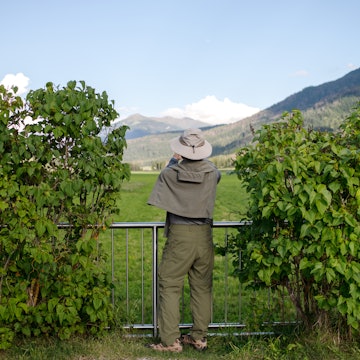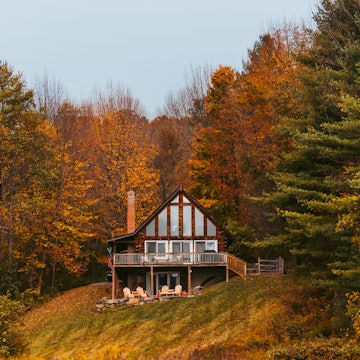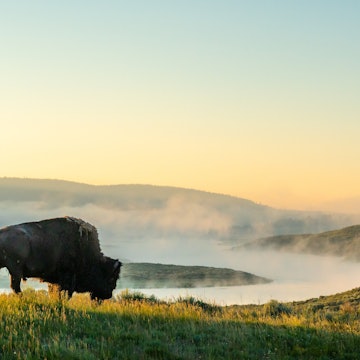
The 9 most memorable things to do in Yellowstone National Park

Apr 14, 2025 • 7 min read

Yellowstone National Park. Danita Delimont/Shutterstock
With its spectacular geysers, waterfalls and abundant wildlife, Yellowstone National Park is a true national treasure.
It’s also the wildest place in the Lower 48 states, making its 2.2 million acres prime real estate for some epic outdoor adventures. Some of the things to do in Yellowstone are life-list draws – watching a pack of wolves hunt a lone elk or backpacking past bison and hot springs in the remote backcountry. Others are less obvious but just as memorable; your first time camping with the kids, or watching a geyser erupt without warning, as if by magic. Yellowstone’s charms are both world-class and subtle. Just be sure you budget enough time to enjoy them.
1. Spot wolves in the Lamar Valley
Wildlife watching is one of Yellowstone’s great draws. There’s nowhere better to spot the park’s iconic megafauna than the Lamar Valley (often called the "Serengeti of North America") and there’s no more pulse-raising or totemic animal than the gray wolf. Head out to the valley’s multiple roadside pullouts just after dawn and you’ll see dozens of other hopefuls waiting with a flask of coffee and a pair of binoculars. The first time you spot a wolf in the wild it’s hard to stop the hairs standing up on the back of your neck. It’s a fundamental, primeval experience not to be missed.
Planning tip: Sign up for a biologist-guided tour with someone like or with Dr Nathan Varley at and and you’ll see much more wildlife than you could by yourself. Plus, you’ll get a local perspective on the reintroduction of wolves to Yellowstone in 1996.

2. Stroll Norris Geyser Basin
Yellowstone’s otherworldly geysers, hot pools and mud pots are perhaps its biggest attractions. Of the park's major thermal basins, Norris Geyser Basin is perhaps the most interesting. Not only is it the hottest and most active basin in the park, it also boasts the world’s tallest geyser and the bulk of the park’s acidic geysers.
The bone-white basin is packed with steaming azure pools, multi-colored runoff streams and hissing fumaroles. Visit early in the morning fog or at sunset for the full "Land of the Lost" vibe. It’s the kind of place where it feels like the Earth is still being formed, and where a dinosaur could stroll out of the forest at any moment and no one would raise an eyebrow.
3. Bag a Yellowstone Summit
For epic views and a well-earned sense of achievement it’s hard to beat a hike up to the top of one of Yellowstone’s peaks. Park-maintained trails lead up a dozen mountains, all of them nontechnical and offering stunning views over the park’s valleys, lakes and mountain ranges.
Several of the park’s most popular hikes include summits, notably Washburn Peak (10,223ft/3116 m) and Bunsen Peak (8527ft/2599m), but lesser-known mountain trails see much lighter traffic. Try Avalanche Peak (10,440ft/3180m) in the park’s southeastern corner for dramatic views over Yellowstone Lake and the rugged Absaroka Range, or head to Sepulcher Mountain (9646ft/2940m) in the more popular northwestern corner of the park, near Mammoth junction.
Detour: For an overnight trip consider Observation Peak (9397ft/2864m), whose backcountry site 4P1 sits just below the summit for guaranteed private sunset views (you need to hike in all your water). Alternatively, tackle Electric Peak (10,969ft, 3343m), the highest mountain in the Gallatin Range, after a backcountry overnight in the upper Gardner River valley.

4. Soothe your aching muscles on a backcountry soak
Yellowstone boasts thousands of enticing hot springs but most of them will boil you alive, so it’s important to stick to park-sanctioned soaks! One of the best legal dips is at Boiling River, where underground hot springs merge with the Gardner River to create perfect soaking temperatures. There are no facilities here beyond an open canopy of stars but it’s a great place to relax after a hard day’s sightseeing.
Detour: The park’s ultimate backcountry soak has to be "Mr Bubbles", a 40ft-wide hot pool deep in the backcountry of Bechler Corner. It’s totally worth the three-day walk to get there! If wild soaking sounds like too much hard work, the Hot Tub Cabins at the Mammoth Hot Springs Hotel come equipped with private hot tubs.
5. Overnight in the Yellowstone backcountry
The ultimate way to immerse yourself in the Yellowstone wilderness is to camp overnight in the backcountry, far from the boardwalks and car parks that define many visitors’ Yellowstone experience. The park offers a fabulous range of backcountry campsites (around 300 in total) some just a mile or two from a trailhead, others within sight of rarely-visited backcountry thermal features or beautifully positioned on a pristine lake shore. There are even a couple of wheelchair-accessible sites. All guarantee solitude and silence, a dazzling night sky and an unfiltered wilderness experience.
Practical tip: You will have to reserve specific backcountry sites well in advance, or be flexible and see what is available two days before you set off. is required year-round for any backcountry overnight stay. All backcountry sites are in grizzly territory, so pack bear spray and know how to store your food safely.
6. Paddle Shoshone Lake on a multi-day canoe trip
Several of Yellowstone’s lakes offer potential for canoeing or kayaking but nothing beats a multi-day trip around serene Shoshone Lake, the largest backcountry lake in the Lower 48 states. You’ll need to portage (carry) your canoe for about 330ft (100m) up the Lewis River but once on Shoshone Lake, you have the choice of 16 fantastic backcountry lakeshore campsites. There, you can dock, camp and watch the lake blush into a dozen shades of sunset mauve, as waves lap against your own private section of shore. It’s a fabulous way to explore a hidden side to the park.
Detour: With enough time you can explore the little-visited backcountry thermal features of Shoshone Geyser Basin, just off the lake’s remote southwestern shore.

7. Glide past geysers and ghost trees on cross-country skis
In many ways, Yellowstone is at its most dramatic during the frozen winter months of January and February. Thatʻs when sub-zero temperatures cover the trees with great mantles of ice and force wildlife into the low-lying thermal areas, where they are so much easier to spot. Few activities compare with gliding across the silent, white landscape on skis, passing ice-coated bison and the occasional fox, with no sound audible, save for the squeaking of your skis on fresh snow. Top off the experience with a warming hot chocolate by the crackling open fire of Old Faithful Snow Lodge.
Practical tip: To visit the park’s southern geyser basins in winter, you’ll need to book accommodation and snowcoach transfers up to a year in advance via the park concessionaire . The northern section of the park between Mammoth and Cooke City is open year-round for easier access.
8. Go fly-fishing in Slough Creek
Yellowstone is world famous for its fly-fishing. Where else can you cast your line for cutthroat trout in sight of a herd of grazing bison or a steaming hot spring? Slough (pronounced "slew") Creek and Pebble Creek in the park’s northwestern corner are the most hallowed fly fishing spots, closely followed by the Madison and Gibbon rivers further south. Fly-fishing outfitters and shops in the gateway towns are ready to offer whatever gear, guides or advice you might need, including helping you pick the perfect seasonal fly.
Planning tip: Anglers over 16 years old require a (US$40 for three days; US$55 for seven days), which can be bought from a visitor center or Yellowstone General Store.
9. View Yellowstone’s very own Grand Canyon
Ice Age-era melting helped the Yellowstone River carve its dramatic course through softened thermally-heated rock, resulting in today’s Grand Canyon of the Yellowstone gorge tinted with a dozen shades of oxidized orange, pink and rust red. There are several ways to view the canyon: craning your neck beside the 308ft (94m) drop of the Lower Falls; admiring big picture views of the entire canyon from Artist Point; or feeling the spray on your face after descending the 328 steps of Uncle Tom’s Trail. A half-dozen accessible viewpoints line the north and south rims, or you can hike between viewpoints for peaceful vehicle-free vistas.
Plan with a local











